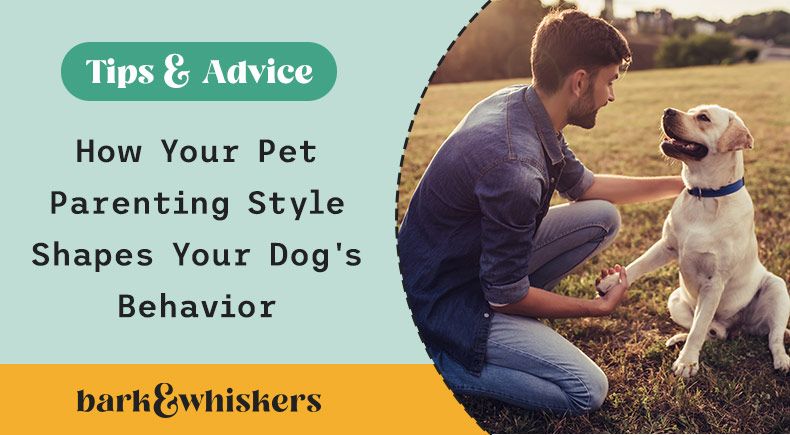How Your Pet Parenting Style Shapes Your Dog's Behavior
Just as the way humans parent their children is an important factor in a child's development & mental health, the bond between dog parents and their pets influences canine behavior. What's your pet parenting style and how is it shaping your dog's responsiveness, attachment and puzzle-solving skills?

STORY AT-A-GLANCE
- According to the results of a new study, “authoritative” pet parents, defined as those with high expectations and high responsiveness to their dogs, have the most positive influence on the behavior and cognition of their pets
- Dogs of authoritative owners more often display secure attachment styles, are highly responsive to social cues, prefer to be close to their owners vs. an unfamiliar person, and are more independently persistent in solving problems
- Dogs with “authoritarian” (high expectations, low responsiveness) or “permissive” (low expectations, low responsiveness) owners tend to be less securely attached to their humans, and less persistent in solving problems
- In addition to the effect of pet parenting styles on dogs, thanks to oxytocin and other feel-good hormones, both humans and canines receive many physical and emotional benefits when we interact
- Through the process of domestication, dogs have also learned to read human facial expressions and respond to our communicative intent
According to the results of a new study, dog parents who have high expectations and are highly responsive to their pet’s behavior and needs, have canine family members who are more secure when away from their owners, and who are more persistent problem solvers.
The Oregon State University study was published in September 2022 in the journal Animal Cognition.1 According to Monique Udell, an associate professor at Oregon State, expert on dog behavior, and study co-author:
"We found that pet parenting style does predict patterns of dog behavior and cognition. This an important finding because it suggests that dog owners who take the time to understand and meet their dog's needs are more likely to end up with secure, resilient dogs."2
Exploring the Bond Between Humans and Their Dogs
There’s been a tremendous amount of research in recent years into what makes our canine companions tick, including how their home environment and prior experiences influence their behavior.
Now, researchers have begun investigating the bond between dog parents and their pets, and how it influences dogs’ behavior. According to study co-author and behavioral scientist Lauren Brubaker, in many ways, research into human-dog relationships is similar to human psychology research.
The way in which humans parent their children has proved to be an important factor in a youngster’s development, mental health, intellectual success, social cognition, attachment, and job performance. For their study, one of the first of its kind, Brubaker and Udell set out to explore the ways in which the quality of the human-dog relationship influences a dog’s performance on behavioral and cognitive tests.
What’s Your Pet Parenting Style?
Udell and Brubaker surveyed 48 dog owners about their pet parenting styles. Based on their survey responses, the owners were put into one of three categories similar to those used in human parenting research:
- Authoritative (high expectations, high responsiveness)
- Authoritarian (high expectations, low responsiveness)
- Permissive (low expectations, low responsiveness)
Next, the dogs were brought to OSU’s Human-Animal Interaction Lab run by Udell and given three behavioral tests:
- Test No. 1: Attachment to owner — Owner-dog pairs are placed in the same room. The owner interacts with the dog when it comes close, then leaves the room and finally returns, reuniting with the dog.
- Test No. 2: Sociability — The owner and an unfamiliar person are in the room with the dog while the researchers study their reactions.
- Test No. 3: Problem solving — The dog attempts to get a treat from a puzzle with different levels of help from the owner.
What the Researchers Learned
- Dogs with authoritative (high expectations, high responsiveness) owners were the most likely to have secure attachment styles, were highly responsive to social cues, preferred to be close to their owner vs. an unfamiliar person, and were more independently persistent in solving problems. In fact, only dogs in this group successfully solved the puzzle task.
- Dogs with authoritarian (high expectations, low responsiveness) owners were more likely to be insecurely attached to their owners compared to dogs in the authoritative group. However, these dogs also spent more time trying to be close to their owner compared to the unfamiliar person in the sociability test.
- Dogs with permissive (low expectations, low responsiveness) owners followed the social cues of the unfamiliar person but not their owner; however, they spent comparable time in proximity with their owner regardless of the owner’s level of attention to them. These dogs were also less persistent at solving the puzzle.
Based on these results, the researchers concluded that the dog-owner bond may be functionally and emotionally similar to the parent-child bond.
The Human-Dog Bond Generates Feel-Good Hormones
In the event anyone reading here today believes the human-dog bond is a one-way street affecting only our furry BFFs, rest assured that’s not the case! Studies prove there is true chemistry between dogs and their humans, and in fact, daily interactions with your canine companion have a measurably uplifting effect on your biochemistry, thanks to a hormone called oxytocin, sometimes called the “hug hormone” or the “love chemical.”
Oxytocin is a naturally occurring substance in the body that makes skin-to-skin contact feel good. It also acts as a natural painkiller and lowers stress levels and blood pressure.
It has long been established that human-to-human contact, for example, bonding with children or partners, triggers the release of oxytocin. More recently, studies have revealed that bonding with a completely different species also promotes release of this wonderful hormone.
In 2003, a study conducted at the University of Pretoria in South Africa revealed some fascinating insights about the interaction between dogs and their humans.3
Dog parents sat on a rug on the floor with their dogs and for 30 minutes, they focused solely on their pets. They talked softly to them, and stroked, scratched and petted them. The owners’ blood was drawn at the beginning and again at the end of the 30-minute session.
The researchers found that the dog owners’ blood pressure decreased, and they showed elevated levels not only of oxytocin, but also several other hormones. These included beta-endorphins, which are associated with both pain relief and euphoria; prolactin, which promotes bonding between parent and child; phenylethylamine, which is increased in people involved in romantic relationships; and dopamine, which heightens feelings of pleasure.
Interestingly, all the same hormones were also elevated in the dogs, which suggests the feelings of attachment are mutual! Next, the dog parents sat in the room and read a book for 30 minutes. None of the hormones, including oxytocin, increased as much as they did during the session with the dogs. A decade ago, a Japanese study proved that when our dogs gaze at us, our oxytocin levels increase.4
The study involved 55 dogs and their owners. The people whose dogs gazed at them for two minutes or longer showed higher levels of oxytocin than owners whose dogs gazed at them for less time. They also claimed to be happier with their dogs than owners whose dogs’ gaze was only around a minute long.
In a 2011 Swedish study, researchers found that people who kissed their dogs frequently had higher levels of oxytocin than other owners.5 And along with kissing, there were two other factors that contributed to elevated levels of oxytocin.
One was that the owners perceived their relationship with their dog to be pleasurable rather than difficult or a chore, and the other was that they offered fewer treats to their pet, preferring to offer attention and affection instead.
Did You Know Dogs Can Read Our Facial Expressions?
In 2018, a team of Italian researchers published a facial expression study involving 26 dogs.6 As the dogs ate, the scientists showed them photos of the same two human faces (a man and a woman).
The pictures were deliberately positioned to the sides of the dogs’ line of sight and showed the humans intensely expressing one of six emotions — anger, fear, happiness, sadness, surprise, or disgust. A second face displayed a neutral (nonemotional) expression.
The researchers observed that when the dogs saw facial expressions such as anger, fear, and happiness, their heart rates accelerated, and they tended to turn their heads to the left. They also took longer to resume eating than when they were shown the neutral face.
The scientists concluded the dogs were experiencing more stress while these three particular facial expressions were displayed, and theorized that the happy face caused stress because dogs instinctively view bared teeth as threatening. Interestingly, when the dogs were shown surprised facial expressions, they remained relaxed and tended to turn their head to the right.
They showed no “side bias” with their heads when shown pictures of sadness, disgust, or a neutral expression.
These study results are further evidence of just how closely connected dogs are with people. According to the researchers, the dogs turning their heads either left or right also suggests our furry companions use different parts of their brains to process human emotions.
The right side of the brain plays a more important role in regulating the sympathetic outflow to the heart and is fundamental in controlling the fight-or-flight response necessary for survival. Arousing, negative emotions seem to be processed by the right hemisphere of a dog’s brain, and more positive emotions by the left hemisphere.
Dogs Also Respond to Our Communicative Intent
Research shows that dogs track human eye movements, and eye movements are linked with intent.
A study published in 2012 in the journal Current Biology compared this ability in dogs to a similar one shown by human babies.7 For the study, 16 dogs were shown videos of a person turning toward one of two identical objects. In one video, the person looks directly at the dog and says in a lively voice, "Hi dog!" In the other video, the person avoided eye contact and said, 'Hi dog,' in a low voice.
An eye tracker was used to capture the dogs' reactions, and researchers concluded from the data collected that the dogs were more likely to look at the object in the video featuring the more communicative person. This was the first study to use eye-tracking techniques to observe how dogs interact with people.
The study brought out an additional aspect of dogs' attentiveness to humans by demonstrating that when a dog's gaze follows a human, it's not simply a reflex. It's linked to the human's “communicative intent.”
Even though your dog's brain doesn't process information the same way a human child's does, his ability to interact with you at this level helps strengthen the bond you share. And when you consider the biological differences between humans and canines, the fact that we’re able to communicate back and forth is pretty remarkable!
Sources and References
- 1 Brubaker, L. and Udell, M.A.R. Animal Cognition, September 30, 2022
- 2 Phys.org, October 11, 2022
- 3 Veterinary Journal, May 2003, 165(3):296-301
- 4 Hormones and Behavior, March 2009, 55(3):434-41
- 5 Anthrozoos: A Multidisciplinary Journal of the Interactions of People & Animals, Vol. 24, No. 3, September 2011, pp 301-315(15)
- 6 Learning & Behavior, June 19, 2018, pp 1-12
- 7 Current Biology, Volume 22, Issue 3, 209-212, 05 January 2012
Today's Pet Video:
He'd Always Wanted a Cat, but Phillip Was Kind of Like a Dog
When two adorable orange kittens appeared on a shelter’s website, Josiah went to claim them. While one had already been adopted, Phillip jumped straight into his arms!










